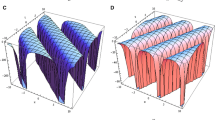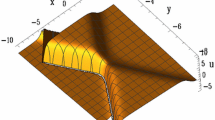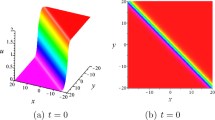Abstract
Many important physical situations such as fluid flows, plasma physics and solid-state physics have been described by (3+1)-dimensional generalized shallow water equation. In this article, we construct new periodic solitary wave solutions for the (3+1)-dimensional generalized shallow water equation by using the auto-Bäcklund transformation and a direct test function. These obtained new periodic solitary wave solutions enrich the solution structure. Evidently, with the help of symbolic computation, the physical structure for these periodic solitary wave solutions is presented with some figures. The direct test function approach can be also applied to solve other nonlinear differential equations.
Similar content being viewed by others
Explore related subjects
Discover the latest articles, news and stories from top researchers in related subjects.Avoid common mistakes on your manuscript.
1 Introduction
Nonlinear evolution equations (NLEEs) are widely used to describe complex sciences phenomena such as the marine engineering, fluid dynamics, plasma physics, chemistry and physics and many other applications [1,2,3,4,5,6,7,8,9,10,11,12,13,14,15]. During the past several decades, many efficient methods have been proposed to obtain the exact solutions of NLEEs such as inverse scattering method [16], the homotopy perturbation method [17], Hirota direct method [18,19,20,21,22,23,24,25,26], hyperbolic function method [27], homogeneous balance method [28,29,30], F-expansion method [31], exp function method [32,33,34], the extended mapping method [35], the (G\('\)/G)-expansion method [36,37,38] and three-wave approach [39,40,41,42,43,44].
In this paper, we will research the following (3+1)-dimensional generalized shallow water equation:
Equation (1) has been used in weather simulations, tidal waves, river and irrigation ows, tsunami prediction and researched in different ways. Tian [45] obtained the soliton-type solutions of Eq. (1) by using the generalized tanh algorithm method. Zayed [46] got the traveling wave solutions of Eq. (1) by using the (G\('\)/G)-expansion method. Tang [47] presented the Grammian and Pfaffian solutions of Eq. (1) by the Hirota bilinear form. Multiple soliton solutions of Eq. (1) are discussed by Zeng [1]. Next, we will discuss the new periodic solitary wave solutions for Eq. (1) by using the direct test function method. The direct test function is used instead of text function in the original Hirota bilinear method. If the bilinear equation of nonlinear evolution equations is available, then rich variety of exact solutions can be presented by using the direct test function method. These exact solutions are found to possess dynamic characteristics. This used method being simple and straightforward than the method in Refs. [45,46,47].
The paper is organized as follows: in Sect. 2, by using the auto-Bäcklund transformation and a direct test function, new periodic solitary wave solutions for the (3+1)-dimensional generalized shallow water equation are obtained. In Sect. 3, the conclusions are presented.
2 New periodic solitary wave solutions for the (3+1)-dimensional generalized shallow water equation
According to the idea of the extended variable-coefficient homogeneous balance method (EvcHB) [48], the solutions of Eq. (1) can be supposed as follows:
where \(\xi =\xi (x,y,z,t)\), \(\eta =\eta (y,z,t)\) and \(u_0(x,y,z,t)\) is a special solution of Eq. (1). Substituting Eq. (2) into (1), we have the following auto-Bäcklund transformation:
Aiming at the new periodic solitary wave solutions, we suppose that \(\sigma (\eta )=0\), \(u_0(x,y,z,t)=0\) and a direct test function
where \(\theta _i=\alpha _i\,x+\beta _i\,y+\gamma _i\,z+\delta _i\,t,i=1,2,3,4\) and \(\alpha _i\), \(\beta _i\), \(\gamma _i\), \(\delta _i\) are constants to be determined later. Substituting Eq. (9) into (3)–(8) and equating all the coefficients of different powers of \(e^{\theta _1}\), \(e^{-\theta _1}\), \(\tan \left( \theta _2\right) \), \(\tan \textit{h} \left( \theta _3\right) \) and constant term to zero, we can obtain a set of algebraic equations for \(\alpha _i\), \(\beta _i\), \(\gamma _i\), \(\delta _i\), \(k_i(i=1,2,3,4)\). Solving the system with the aid of Mathematical, we obtain the following results:
Case(1)
where \(\alpha _1\), \(\delta _1\), \(\beta _3\), \(k_1\) and \(k_3\) are arbitrary constants. Substituting Eq. (10) into (9), we have
Therefore, we obtain the first new periodic solitary wave solution for Eq. (1):
The evolution and mechanical feature of Eq. (12) are shown in Figs. 1, 2.
The solitary wave solution (12) at \(k_1=k_3=\delta _1=-2\), \(\alpha _1=-1\), \(\beta _3=5\), \(z=10\), a \(t = -5\), b \(t = 0\), c \(t = 5\)
Case(2)
where \(\alpha _1\), \(\delta _1\), \(\beta _2\), \(k_1\) and \(k_2\) are arbitrary constants. Substituting Eq. (13) into (9), we have
Therefore, we obtain the second new periodic solitary wave solutions for Eq. (1):
The evolution and mechanical feature of Eq. (15) are shown in Figs. 3, 4 and 5.
The solitary wave solution (12) at \(k_1=k_3=\delta _1=-2\), \(\alpha _1=-1\), \(\beta _3=5\), \(y=-1\), a \(z = -20\), b \(z = 0\), c \(z = 20\)
The solitary wave solution (15) at \(k_1=k_2=\delta _1=-2\), \(\alpha _1=-1\), \(\beta _2=5\), \(z=10\), a \(t = -5\), b \(t = 0\), c \(t = 5\)
The solitary wave solution (15) at \(k_1=k_2=\delta _1=-2\), \(\alpha _1=-1\), \(\beta _2=5\), \(t=-5\), a \(x = 5\), b \(x = 10\), c \(x = 15\)
The solitary wave solution (15) at \(k_1=k_2=\delta _1=-2\), \(\alpha _1=-1\), \(\beta _2=5\), \(z=10\), a \(x = -10\), b \(x = 0\), c \(x = 10\)
Case(3)
where \(\alpha _1\), \(\delta _1\), \(\beta _1\), \(\beta _2\), \(\beta _3\), \(k_2\) and \(k_3\) are arbitrary constants. Substituting Eq. (16) into (9), we have
Therefore, we obtain the third new periodic solitary wave solutions for Eq. (1):
The evolution and mechanical feature of Eq. (18) are shown in Figs. 6, 7.
The solitary wave solution (18) at \(k_3=k_2=\beta _1=\delta _1=-2\), \(\alpha _1=1\), \(\beta _2=\beta _3=-5\), \(z=10\), a \(t = -10\), b \(t = 0\), c \(t = 10\)
The solitary wave solution (18) at \(k_2=\beta _1=\delta _1=-2\), \(k_3=0\), \(\alpha _1=1\), \(\beta _2=\beta _3=-5\), \(t=-5\), a \(y = -10\), b \(y = 0\), c \(y = 10\)
Case(4)
where \(\alpha _1\), \(\delta _1\), \(\beta _1\), \(\delta _2\), \(\delta _3\), \(k_2\) and \(k_3\) are arbitrary constants. Substituting Eq. (19) into (9), we have
Therefore, we obtain the fourth new periodic solitary wave solutions for Eq.(1):
The evolution and mechanical feature of Eq. (21) are shown in Figs. 8, 9.
The solitary wave solution (21) at \(k_3=k_2=\beta _1=\delta _1=-2\), \(\alpha _1=1\), \(\delta _2=\delta _3=-5\), \(y=10\), a \(x = -20\), b \(x = 0\), c \(x = 20\)
The solitary wave solution (21) at \(k_3=k_2=\beta _1=\delta _1=-2\), \(\alpha _1=1\), \(\delta _2=\delta _3=-5\), \(y=10\), a \(t = -10\), b \(t = 0\), c \(t = 10\)
3 Conclusion
By using the auto-Bäcklund transformation and a direct test function, we obtain new periodic solitary wave solutions of the (3+1)-dimensional generalized shallow water equation. Moreover, the evolution and mechanical feature of solutions (12), (15), (18) and (21) are clearly presented in Figs. 1, 2, 3, 4, 5, 6, 7 , 8 and 9.
The direct test function method is reliable and effective and obtains many new periodic solitary wave solutions. The applied method will be used in further works to seek more entirely periodic solitary wave solutions of higher dimensional nonlinear evolution equations.
References
Zeng, Z.F., Liu, J.G., Nie, B.: Multiple-soliton solutions, soliton-type solutions and rational solutions for the, (3+1)-dimensional generalized shallow water equation in oceans, estuaries and impoundments. Nonlinear Dyn. 86(1), 667–675 (2016)
Ma, W.X., Zhou, Y.: Reduced D-Kaup–Newell soliton hierarchies from \(sl(2, R)\) and \(so(3, R)\). Int. J. Geom. Methods Mod. Phys. 13, 1650105 (2016)
Ma, W.X., Meng, J.H., Zhang, M.S.: Nonlinear bi-integrable couplings with Hamiltonian structures. Math. Comput. Simul. 127, 166–177 (2016)
Mirzazadeh, M., Arnous, A.H., Mahmood, M.F., Zerrad, E., Biswas, A.: Soliton solutions to resonant nonlinear schrödinger’s equation with time-dependent coefficients by trial solution approach. Nonlinear Dyn. 81(1–2), 1–6 (2015)
Mirzazadeh, M.: Soliton solutions of Davey–Stewartson equation by trial equation method and ansatz approach. Nonlinear Dyn. 82(4), 1775–1780 (2015)
Ma, W.X., Qin, Z.Y., Lü, X.: Lump solutions to dimensionally reduced p-gKP and p-gBKP equations. Nonlinear Dyn. 84, 923–931 (2016)
Wazwaz, A.M.: Compactons, solitons and periodic solutions for some forms of nonlinear Klein–Gordon equations. Chaos Soliton Fract. 28(4), 1005–1013 (2006)
Wazwaz, A.M.: The \(tanh\) method: solitons and periodic solutions for the Dodd–Bullough–Mikhailov and the Tzitzeica–Dodd–Bullough equations. Chaos Soliton Fract. 25(1), 55–63 (2005)
Wazwaz, A.M.: Multiple-front solutions for the Burgers–Kadomtsev–Petviashvili equation. Appl. Math. Comput. 200(1), 437–443 (2008)
Wazwaz, A.M.: Solitons and singular solitons for the Gardner-KP equation. Appl. Math. Comput. 204(1), 162–169 (2008)
Eslami, M.: Soliton-like solutions for the coupled Schrödinger–Boussinesq equation. Optik Int. J. Light Electron. Opt. 126(23), 3987–3991 (2015)
Eslami, M.: Exact traveling wave solutions to the fractional coupled nonlinear Schrodinger equations. Appl. Math. Comput. 285, 141–148 (2016)
Eslami, M.: Solitary wave solutions for perturbed nonlinear Schrodinger’s equation with Kerr law nonlinearity under the DAM. Optik Int. J. Light Electron. Opt. 126(13), 1312–1317 (2015)
Eslami, M., Mirzazadeh, M., Neirameh, A.: New exact wave solutions for Hirota equation. Pramana 84(1), 1–6 (2015)
Eslami, M., Rezazadeh, H.: The first integral method for Wu-Zhang system with conformable time-fractional derivative. Calcolo 53(3), 1–11 (2016)
Ablowitz, M.J., Clarkson, P.A.: Solitons, Nonlinear Evolution Equations and Inverse Scattering Transform. Cambridge University Press, London (1990)
Sakthivel, R., Chun, C., Lee, J.: New travelling wave solutions of Burgers equation with finite transport memory. Z. Naturforsch. A 65, 633–640 (2010)
Hirota, R.: Exact solutions of the Korteweg-de Vries equation for multiple collision of solitons. Phys. Rev. Lett. 27, 1192–1194 (1971)
Wazwaz, A.M.: Multiple soliton solutions and multiple singular soliton solutions for (2+1)-dimensional shallow water wave equations. Phys. Lett. A. 373, 2927–2930 (2009)
Wazwaz, A.M., El-Tantawy, S.A.: A new integrable (3+1)-dimensional KdV-like model with its multiple-soliton solutions. Nonlinear Dyn. 373, 1–6 (2015)
Wazwaz, A.M.: New (3+1)-dimensional nonlinear evolution equations with mKdV equation constituting its main part: multiple soliton solutions. Chaos Soliton Fract. 76, 93–97 (2015)
Wazwaz, A.M.: A study on a (2+1)-dimensional and a (3+1)-dimensional generalized Burgers equation. Appl. Math. Lett. 31, 41–45 (2014)
Ma, W.X., Zhu, Z.: Solving the (3+1)-dimensional generalized KP and BKP equations by the multiple exp-function algorithm. Appl. Math. Comput. 218(24), 11871–11879 (2012)
Alnowehy, A.G.: The multiple exp-function method and the linear superposition principle for solving the (2+1)-dimensional Calogero–Bogoyavlenskii–Schiff equation. Z. Naturforsch. 70(9), 775–779 (2015)
Ma, W.X., Huang, T., Zhang, Y.: A multiple exp-function method for nonlinear differential equations and its application. Phys. Scr. 82(6), 065003 (2010)
Wazwaz, A.M.: Multiple-soliton solutions for the Calogero–Bogoyavlenskii–Schiff, Jimbo–Miwa and YTSF equations. Appl. Math. Comput. 203, 592–597 (2008)
Xie, T.C., Li, B., Zhang, H.Q.: New explicit and exact solutions for the Nizhnik–Novikov–Vesselov equation. Appl. Math. E Notes 1, 139–142 (2001)
Fan, E., Zhang, H.: Anote on the homogeneous balance method. Phys. Lett. A 246, 403–406 (1998)
Fan, E.: Two new applications of the homogeneous balance method. Phys. Lett. A 265, 353–357 (2000)
Senthilvelan, M.: On the extended applications of homogeneous balance method. Appl. Math. Comput. 123, 381–388 (2001)
Zhang, S.: The periodic wave solutions for the (2+1) dimensional Konopelchenko–Dubrovsky equations. Chaos Solitons Fract. 30, 1213–1220 (2006)
El-Sabbagh, M.F., Ali, A.T.: Nonclassical symmetries for nonlinear partial differential equations via compatibility. Commun. Theor. Phys. 56, 611–616 (2011)
El-Sabbagh, M.F., Hasan, M.M., Hamed, E.: The Painlevé property for some nonlinear evolution equations. In: Proceedings of the France-Egypt Mathematical Conference, Cairo, 3–5 May (2010)
El-Sabbagh, M.F., Ali, A.T., El-Ganaini, S.: New abundant exact solutions for the system of (2+1)-dimensional Burgers equations. Appl. Math. Inform. Sci. 2(1), 31–41 (2008)
Bai, C.J., Zhao, H., Xu, H.Y., Zhang, X.: New traveling wave solutions for a class of nonlinear evolution equations. Int. J. Mod. Phys. B 25, 319–327 (2011)
Qawasmeh, A., Alquran, M.: Soliton and periodic solutions for (2+1)-dimensional dispersive long water-wave system. Appl. Math. Sci. 8(50), 2455–2463 (2014)
Alquran, M., Qawasmeh, A.: Soliton solutions of shallow water wave equations by means of \((G^{\prime }/G)\)-expansion method. J. Appl. Anal. Comput. 4(3), 221–229 (2014)
Qawasmeh, A., Alquran, M.: Reliable study of some new fifth-order nonlinear equations by means of \((G^{\prime }/G)\)-expansion method and rational sine–cosine method. Appl. Math. Sci. 8(120), 5985–5994 (2014)
Wang, C.J., Dai, Z.D., Mu, G., Lin, S.Q.: New exact periodic solitary-wave solutions for new (2+1)-dimensional KdV equation. Commun. Theor. Phys. 52, 862–864 (2009)
Dai, Z.D., Lin, S.Q., Fu, H.M., Zeng, X.P.: Exact three-wave solutions for the KP equation. Appl. Math. Comput. 216(5), 1599–1604 (2010)
Zeng, X.P., Dai, Z.D., Li, D.L.: New periodic soliton solutions for the (3 + 1)-dimensional potential-YTSF equation. Chaos Soliton Fract. 42, 657–661 (2009)
Dai, Z.D., Li, S.L., Dai, Q.Y., Huang, J.: Singular periodic soliton solutions and resonance for the Kadomtsev–Petviashvili equation. Chaos Soliton Fract. 34(4), 1148–1153 (2007)
Dai, Z.D., Liu, Z.J., Li, D.L.: Exact periodic solitary-wave solution for KdV equation. Chin. Phys. Lett. A 25(5), 1151–1153 (2008)
Dai, Z.D., Huang, J., Jiang, M.R., Wang, S.H.: Homoclinic orbits and periodic solitons for Boussinesq equation with even constraint. Chaos Soliton Fract. 26, 1189–1194 (2005)
Tian, B., Gao, Y.T.: Beyond travelling waves: a new algorithm for solving nonlinear evolution equations. Comput. Phys. Commun. 95, 139–142 (1996)
Zayed, E.M.E.: Traveling wave solutions for higher dimensional nonlinear evolution equations using the \((G^{\prime }/G)\) expansion method. J. Appl. Math. Inf. 28, 383–395 (2010)
Tang, Y.N., Ma, W.X., Xu, W.: Grammian and Pfaffian solutions as well as Pfaffianization for a (3+1)-dimensional generalized shallow water equation. Chin. Phys. B 21, 070212 (2012)
Li, Y.Z., Liu, J.G.: Auto-Bäcklund transformation and new exact solutions of the generalized variable-coefficients 2-dimensional Korteweg-de Vries model. Phys. Plasmas 14(2), 023502 (2007)
Acknowledgements
We would like to thank editor and the referees for their timely and valuable comments.
Author information
Authors and Affiliations
Corresponding author
Additional information
Project supported by National Natural Science Foundation of China (Grant No 81260644) and Special project of science and Technology Department of Jiangxi provincial science and Technology Department (Grant No 20151BBG70031).
Rights and permissions
About this article
Cite this article
Liu, JG., He, Y. New periodic solitary wave solutions for the (3+1)-dimensional generalized shallow water equation. Nonlinear Dyn 90, 363–369 (2017). https://doi.org/10.1007/s11071-017-3667-y
Received:
Accepted:
Published:
Issue Date:
DOI: https://doi.org/10.1007/s11071-017-3667-y
Keywords
- Auto-Bäcklund transformation
- Periodic solitary wave solutions
- Generalized shallow water equation
- Symbolic computation













